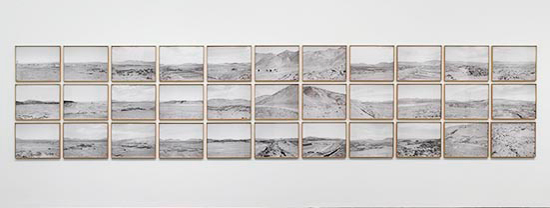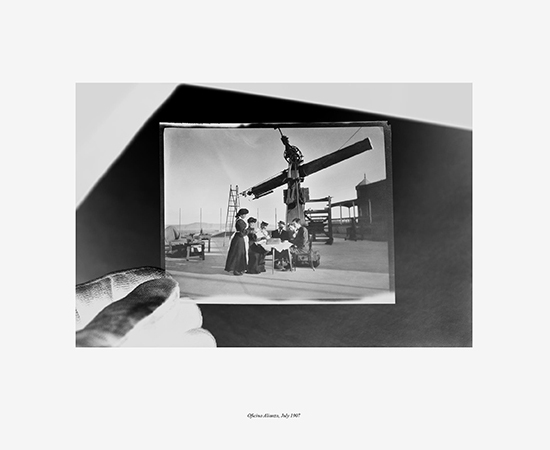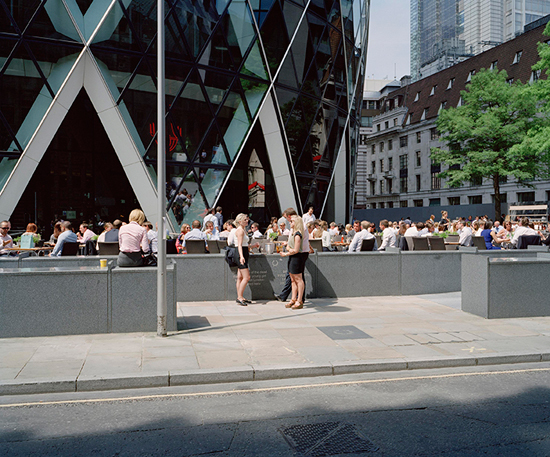| SIMON DENISON IMAGE & TEXT |
| PREVIOUS | NEXT |
XAVIER RIBAS: NITRATE Bluecoat, Liverpool
Xavier Ribas’s Nitrate is a complex and ambitious body of work which addresses global capitalism, the disparities of wealth and power between classes and nations and the legacies of history. In some ways, it is more akin to politically-engaged, campaigning history writing than to documentary photography as traditionally conceived. New picture-making plays a part, but only a part, in this extensively researched project which brings together historical photographs, artefacts and texts from various sources and time periods, to construct an elaborate critical interpretation of national and international power relations both past and present. The focus of the work is the pre-First World War sodium nitrate extraction industry in the Atacama Desert of northern Chile, which was largely in the hands of British companies operating out of Liverpool and the City of London that had purchased operating concessions from the Chilean government. Nitrate was used as the basis for fertilisers and explosives, and Chile was the principal known source. Conditions for workers in the industry, we are told, were oppressive. A statement of workers’ grievances is presented, dated 1904. Three years later, 300 striking workers were shot dead by the Chilean army. British industrialists and financiers, meanwhile, enjoyed the fruits of wealth. One was Henry Hucks Gibbs, Lord Aldenham. We learn of his refined life and cultured interests: an art collector, historian and philologist, he was a major contributor to the Oxford English Dictionary. Ribas develops his exploiters-vs-exploited story by means of two imaginative leaps. First, he draws attention to two IRA bombs in the City of London, in 1992 at the Baltic Exchange and 1993 in Bishopsgate, close to the site of Gibbs’s former HQ. The bombs were made from nitrate-based explosive. Second, he covers the 1907 Lowell Expedition, an astronomical expedition sent to Oficina Alianza, location of one of Gibbs’s extraction works, to take photographs of Mars through clear Andean skies. In the context of a story about globalised exploitation of natural resources and people, set in the driest landscape on Earth, the poignancy of Lowell is that its mission was to test the utopian hypothesis that there were canals on Mars, dug by Martians co-operating on a global scale to share diminishing water resources. Travel writer Mabel Loomis Todd, wife of the expedition’s leader, spent her days roaming the region with a camera and took a number of remarkable snapshots of nitrate workers at their work. These pictures have not been seen publicly before. Nitrate presents a great deal of text alongside its images; and in the comments book, a number of disgruntled visitors question whether the work is appropriate for gallery exhibition. The show is indeed challenging for a visitor on foot to absorb, but its spatial arrangement carries a certain communicative force. Two groups of works face one another across the length of the main exhibition hall, signifying multiple forms of distance: records of workers’ grievances, and notes about Gibbs, including a small photograph of a specimen Araucaria Araucana, national tree of Chile, growing luxuriantly in the grounds of Tyntesfield, Gibbs’s former country estate near Bristol. Linking the two on a side wall, in what may be taken as a two-way causal chain, is a grid of images of abandoned extraction sites, records of the massive efforts of historic labour and of the exhaustion of natural resources in the Atacama Desert. A separate room pairs photographs of a resurgent City of London, where relaxing office workers ignore memorials to the victims of the terrorist attacks of some 20 years ago, with a video of the dusty Chilean town of Iquique, site of the 1907 massacre: an explicit statement about lingering inequalities in the global distribution of wealth. Only a fraction of the Nitrate archive is presented. Other elements can be seen on Ribas’s website and in an accompanying book. The work as a whole is impressively elaborated, intriguing and provocative; a fine example of photography’s potential as a critical research practice. The overall framing of the work, however, seems too simplistic. Nitrate, we are told, is ‘a case study in the exploitative policies of extractionism, the act of taking non-renewable natural resources from others without any form of return’: thus the historic purchase of mineral licences from the Chilean government is cast crudely as theft. The project is said to trace nitrate’s journey from its origins to its ultimate destination, namely to form ‘part of the material and symbolic inheritance of mansions and estates in London and the English countryside’; but the implication that profits all ended up as the property of a few men in charge is a caricature of the complex flow of wealth in a capitalist economy. The show’s juxtapositions suggest we are meant to see British profits as blood money, yet Chile’s brutal labour-relations practices, far from unique for the period, were not the consequence of nitrate extraction, but rather the context, belonging to a different era and culture, in which it operated. A ‘case study’ is one from which lessons can be drawn, but useful lessons require a far more nuanced reading. Equally troubling is Ribas’s framing of the IRA strikes on the City. ‘With the explosions on the streets of the financial district of London, the transformative qualities of nitrate as mineral, commodity and capital come full circle’, he writes. The logic of this statement is too fractured to follow clearly but the implication of ‘comes full circle’ is that of inevitability, payback, and justice served. On his website, Ribas aligns the IRA with other victim groups by describing IRA acts as ‘resistance to colonial impositions’, a phrase omitted from the Bluecoat show. In the light of continuing terrorist atrocities inflicted on Britons, such a phrase might have been seen as a step too far. |
 |
|---|---|
 |
|
 |
|